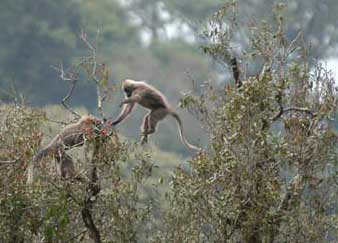Discovered a new monkey genus in Africa
A monkey discovered in Tanzania's high forests last year was so unique that it was classified as a completely new genus - for the first time in 83 years.
 Rungwecebus kipunji is classified as a new genus. ( Photo: LiveScience ) In the classification system, genera are placed under them and on species.
Rungwecebus kipunji is classified as a new genus. ( Photo: LiveScience ) In the classification system, genera are placed under them and on species.
" The discovery of the new genus of the most studied animal group once again reminds us of the small amount of knowledge that we have gathered about the diversity of the earth, " said team member Link. Olson, from Alaska Museum University, said.
Originally, this African monkey species, scientific name Rungwecebus kipunji, was classified as Lophocebus based on photographs taken by the Wildlife Conservation Society (WCS).
Then, when a child was caught and killed in a farmer's trap, people had the opportunity to study it directly. Body structure and DNA analysis show that this species is so different that it deserves to be classified as a separate genus. The last time a new monkey family was found was in 1923, with Allen swamp monkeys in the Congo basin.
Kipunji is grayish brown and a "crown" upright hair on the head, creamy long cheekbones, belly and tail. It stood about 1 meter high and made a strange low cry that was described as a "whistle - bark". Its fur is thick and long so it can live at altitudes above 2,000 meters above sea level, where temperatures often fall below freezing point.
Kipunji monkeys live in groups, from 30 to 36 males and females. Eagles and maybe leopard are their main enemies, but humans also hunt these monkeys to eat meat. Currently, there are only about 500 individuals living in the wild, and will probably be classified as "extremely endangered", needing to be preserved quickly.
T. An
- Monkey skull fossil 6 million years old in China
- Monkey expresses emotions like humans
- Culture in the monkey world
- 40 interesting facts about monkeys that you don't know yet
- Found monkey thought extinct
- Southern Institute of Ecology discovered new genus
- Discovering the monkey species in the rain is sneezing
- Discovered an ancient dinosaur group never seen
- Renovate shopping centers, discover mysterious monkey mummies
- Found a rare monkey on Borneo island
- Discover new monkey species in the Amazon rainforest
- Do monkeys eat bananas?
 Animal 'suffering' after hibernation
Animal 'suffering' after hibernation Why do goats climb well?
Why do goats climb well? Scientists were surprised to see chimpanzees eating turtles
Scientists were surprised to see chimpanzees eating turtles Giant catfish died deadly due to drought in Thailand
Giant catfish died deadly due to drought in Thailand